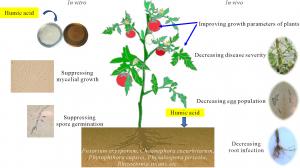Humic acid: a natural defense against soil pathogens
GA, UNITED STATES, July 1, 2025 /EINPresswire.com/ -- Soil-borne fungal diseases threaten crop productivity and quality, and the agricultural sector has long relied on chemicals to manage these pathogens. However, new research is uncovering a natural solution—humic acid. This organic compound, found in soil, has shown impressive antifungal properties, with studies reporting inhibition rates over 80%. Researchers have found that humic acid's chemical structure, rich in functional groups such as carboxyl and phenolic compounds, plays a key role in its ability to stop fungal growth. This breakthrough could reshape disease management strategies, offering a more sustainable approach to soil health.
Soil-borne fungi, responsible for many of the most destructive plant diseases, remain a major challenge in agriculture. While chemical treatments are effective, they often lead to environmental degradation, prompting calls for more sustainable alternatives. Humic acid, an organic compound present in soils, has emerged as a promising solution. Its potential to inhibit harmful fungi without compromising ecological balance positions it as a green alternative to traditional pesticides. Given the urgency of reducing agricultural chemicals, deeper exploration into humic acid's mechanisms is essential to harness its full potential. Based on these challenges, there is a clear need for further research into how humic acid can be used to fight soil-borne diseases.
In a study published on January 31, 2025, in Pedosphere, researchers from the State Key Laboratory of Soil and Sustainable Agriculture, Institute of Soil Science, Chinese Academy of Sciences and Jiangsu Vocational College of Agriculture and Forestry, explore the antifungal potential of humic acid. The study investigates how humic acid's chemical composition, particularly its carboxyl and phenolic groups, enables it to inhibit the growth of soil-borne pathogens. These findings highlight humic acid as a critical component in sustainable agricultural practices, offering new insights into how it could replace harmful chemicals in disease control.
This research shines a spotlight on humic acid's extraordinary ability to suppress soil-borne fungi through several interconnected mechanisms. The study identifies the active components of humic acid, such as carboxyl, phenolic, and methoxy groups, which interact with fungal cells, inhibiting their growth and reproduction. The researchers detail how humic acid affects fungal morphology, disrupts biochemical processes, and alters molecular signaling pathways to prevent fungal spread. The study also presents data showing humic acid's efficacy in combating major pathogens like Fusarium oxysporum, Rhizoctonia solani, and Phytophthora capsici. By demonstrating that humic acid can achieve inhibition rates exceeding 80%, the study advocates for its integration into eco-friendly agricultural practices, providing a viable alternative to conventional fungicides.
Professor Zhongpei Li, a prominent researcher in soil microbiology, comments, "Humic acid's antifungal activity represents a turning point in sustainable agriculture. This review not only consolidates our understanding of humic acid's power against pathogens but also offers hope for reducing our dependence on harmful chemical treatments, paving the way for a healthier, more balanced agricultural ecosystem."
The findings of this research have significant implications for agriculture. Humic acid could become a cornerstone of green farming strategies, offering farmers a natural, effective means of controlling soil-borne fungal diseases. Beyond its fungicidal properties, humic acid enhances soil health, improves microbial diversity, and promotes sustainable crop production. With further research, humic acid could be integrated into broader agricultural practices, offering a scalable, eco-friendly alternative to traditional chemicals. Its use could reduce environmental impact while ensuring food security, supporting the global shift toward more sustainable agricultural systems.
References
DOI
10.1016/j.pedsph.2024.11.007
Original Source URL
https://doi.org/10.1016/j.pedsph.2024.11.007
Funding information
This work was supported by the National Natural Science Foundation of China (Nos. 42207371 and 32071642), the Scientific Project of Jiangsu Vocational College of Agriculture and Forestry, China (No. 2021kj17), and the Key Research Projects of Jiangsu Vocational College of Agriculture and Forestry, China (No. 2023kj14).
Lucy Wang
BioDesign Research
email us here
Legal Disclaimer:
EIN Presswire provides this news content "as is" without warranty of any kind. We do not accept any responsibility or liability for the accuracy, content, images, videos, licenses, completeness, legality, or reliability of the information contained in this article. If you have any complaints or copyright issues related to this article, kindly contact the author above.

